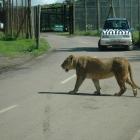Opened in April 1966, the “Lions of Longleat” was the world’s first drive-thru lion reserve outside of Africa. Established by circus showman Jimmy Chipperfield and the Marquis of Bath, the Wiltshire attraction invited visitors to enter the park’s “wild” spaces and to gaze upon the beasts from the comfort and security of their very own automobiles. Fifty animals were initially acquired from animal dealers in Uganda and from zoos throughout the UK and Europe to make up the park’s first group of African lions. Presented as “even better than Africa,” the park was immediately popular with the public (even though the idea provoked significant opposition among those concerned by the prospect of predators in the English rural landscape). In the twelve months following the park’s opening, 188,500 visitor cars entered the estate along with 580 motor coaches. Indeed, massive visitor numbers caused long and winding traffic jams that clogged up nearby villages as visitors flocked for a close encounter with the African wilds.

Longleat Safari Park lion
Longleat Safari Park lion
2011 Anthony Parkes
 This work is licensed under a Creative Commons Attribution-ShareAlike 2.0 Generic License.
This work is licensed under a Creative Commons Attribution-ShareAlike 2.0 Generic License.
This drive-thru safari, like the success of zoological gardens, rested upon the interactions between humans, animals, and technology. These three “actors” have been intertwined in zoos since their first incarnation as architectural technology first confined and then rendered the beasts visible to the curious human eye. Later, architectural innovations, like the barless enclosures of Hagenbeck’s Tierpark near Hamburg around the turn of the twentieth century, made it increasingly possible to create the illusion of animal liberty and “happiness”. At Longleat, technology in the form of the increasingly popular motorcar enhanced the illusion of liberty afforded by the enclosure of animals in a vast open space of some 100 acres by inviting visitors to travel through the park’s “authentic” exotic animalscape.
Historians have been interested in the histories of human interactions with non-human animals for a number of decades. They have shown how animal life has influenced and been influenced by their interactions with humans. Few multi-species spaces compare to the zoological garden in their ability to frame and display an astonishing diversity of human-animal interactions. And yet, the English “safari” park, emergent in the rolling hills of Wiltshire in 1966, has been consistently overlooked. These animal parks were spaces where human-animal interactions were in many ways mediated by the metallic monsters that hummed through them, and they illuminate important characteristics of the ways in which people watched wildlife in the twentieth century.
By allowing visitors to enter large animal spaces, Chipperfield and Bath created the illusion of an eye-to-eye encounter with the wild as the road took a winding course through the lion reserve. The freedom permitted by the automobile joined with the “freedom” of the animals in a space which was explicitly supposed to be evocative of a “pristine” exotic natural world. Furthermore, the winding road allowed for the observation of the animals from an array of angles.
And yet all the while, like the wild things prowling before them, visitors to the park were, in actuality, confined. Indeed, they were shut off from the animals prowling around them. The lions were prevented from escaping into the Wiltshire hills by two layers of metallic fencing, while their paddock was initially patrolled by park rangers. Similarly, visitors were locked inside a metallic cage of their own (though it must be said that these walls were somewhat more permeable than those of the lion enclosure), their “authentic” encounters with wildlife mediated through windows and windscreens. Chipperfield made much of this inversion of captivity.
External video of lions at Longleat Safari. Link: https://youtu.be/woL8cIvTXg0
The video above illustrates the proximity afforded to visitors while they themselves remained confined. This was a wildlife experience mediated to a significant degree by automotive technology. Indeed, the connections between animals and automobility were made explicit in a number of ways. Corporations played around with the relationship between human, animal, and machine in advertisements such as that featured below for Super Fina petroleum. It reflects the almost animalistic (i.e. raw, unrestrained) “power in the tank” provided by the fuel and reflects the triad—of human, animal, machine—at the heart of this wildlife experience

Advertisement by SuperFina Petrol
Advertisement by SuperFina Petrol
“SuperFina Petrol,” in The Lions of Longleat (Warminster, Wiltshire, c. 1966) guidebook.
FINA is a trademark owned by the TOTAL Group.
The copyright holder reserves, or holds for their own use, all the rights provided by copyright law, such as distribution, performance, and creation of derivative works.
The success of Longleat as an alternative wildlife experience to those enshrined in the traditional zoological garden led to the emergence of other such parks throughout the UK (e.g., Windsor in 1969 and Woburn in 1970), as well as in the rest of Western Europe, the US, Japan, and Australia over the ensuing decade or so. Lion reserves in the mould of the Lions of Longleat even popped up in “wild” Africa itself, just outside of Johannesburg, South Africa.
The safari park has prospered for nearly forty years. Soon after the park opened additional safari experiences on the Longleat estate, including close encounters with herbivorous creatures of the African plains and the infamously destructive primates of a monkey reserve in 1967-68. Similarly, a boat cruise allowed for close yet safe encounters with hippos and sea lions. Although no longer operated by the Chipperfield family, the safari experience sits at the heart of the park as a wildlife attraction today. A cursory glance at Longleat’s website reveals the presence of a “Deadly Safari” where visitors—in the safety of their metallic cages—come face-to-face with the world’s most “fearsome” predators. Watching wildlife in these ways remains central to expectations of animal encounters, especially in the Western world. Technology at the center of our lives (like the television) continues to wrap itself around animal forms to enhance the illusion of authenticity (or, often, freedom) while simultaneously disconnecting us from physical encounters with the natural world. Drive-thru experiences such as those at Yellowstone Bear World in the US are now commonplace, as are marine safaris in the “comfort” of a speedboat or aerial savannah safaris which allow a bird’s eye view of some of nature’s “greatest events” like the Serengeti wildebeest migrations. Internet technologies, too, grant unparalleled access to wild things in wild places while fixing our gaze on the smartphone or computer screen. The safari park at Longleat represents a singular moment in a process—especially in Western Europe and the US—that simultaneously widened the lens and deepened the distance between human and non-human animals in the latter half of the twentieth century.
How to cite
Flack, Andy. “Lions, Lords, and Automobiles: Animal Entertainment and Travel Technologies in the Late Twentieth Century.” Environment & Society Portal, Arcadia (2015), no. 17. Rachel Carson Center for Environment and Society. https://doi.org/10.5282/rcc/7305.
ISSN 2199-3408
Environment & Society Portal, Arcadia
 This work is licensed under a Creative Commons Attribution-NonCommercial-ShareAlike 4.0 International License.
This work is licensed under a Creative Commons Attribution-NonCommercial-ShareAlike 4.0 International License.
2015 Andy Flack
This refers only to the text and does not include any image rights.
Please click on an image to view its individual rights status.
- Baratay, Eric, and Elisabeth Hardouin-Fugier. Zoo: A History of Zoological Gardens in the West. London: Reaktion Books, 2001.
- Mandler, Peter. The Fall and Rise of the Stately Home. New Haven: Yale University Press, 1999.
- Schivelbusch, Wolfgang. The Railway Journey: The Industrialization of Time and Space in the Nineteenth Century. Berkley: University of California Press, 2014.
- Sutter, Paul. Driven Wild: How the Fight Against Automobiles Launched the Modern Wilderness Movement. Seattle: University of Washington Press, 2009.
- Urry, John. “The ‘System’ of Automobility.” Theory, Culture & Society 21, no. 4–5 (2004): 25–39.








